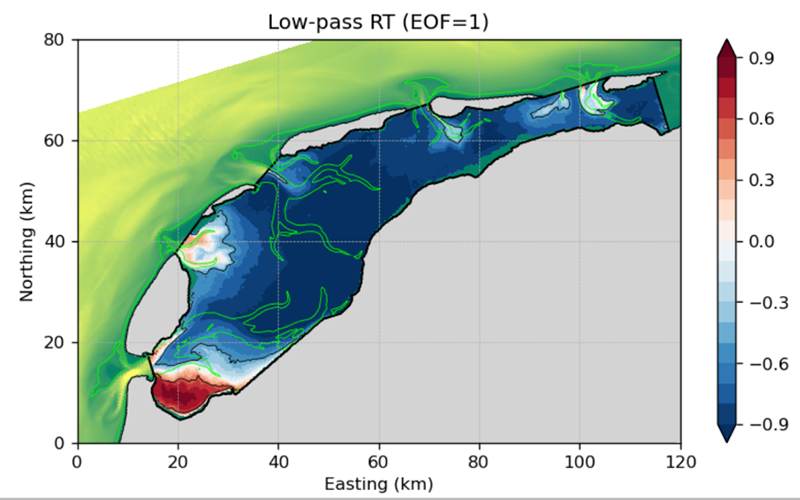J.M. Fajardo Urbina1*, U. Gräwe2, H.J.H. Clercx1, T. Gerkema3, M. Duran-Matute1
1 Eindhoven University of Technology, Eindhoven, Netherlands; 2 Netherlands eScience Center, Amsterdam, Netherlands; 3 Leibniz Institute for Baltic Sea Research, Warnemünde, Rostock, Germany; 4 NIOZ Royal Netherlands Institute for Sea Research, Yerseke, Netherlands.
*corresponding author:
Introduction
The spatio-temporal variability of transport in coastal ecosystems is of primary importance for many biological processes. This is particularly critical in highly heterogeneous regions, like in systems of intertidal basins, where transport can exhibit a strong anisotropic response to different forcing mechanisms like winds. To understand the local and temporal variability of transport and exchange of water and freshwater content within a system and with its surroundings, Lagrangian transport time scales (LTTS), such as the residence and exposure times, are commonly employed. Additional information about the preferential pathways in multiple-inlet systems can be obtained by determining the capture areas of the inlets. Tracers deployed in a capture area have the largest probability of exiting the system through the associated inlet. Here, we study the spatio-temporal variations of the LTTS and the capture areas of inlets in the Dutch Wadden Sea (DWS) and their relation to the dominant forcing mechanisms.
Methods and Results
We employed a 36-year (1980-2015) simulation based on an offline coupling of the General Estuarine Transport Model (GETM) and the Lagrangian model "Parcels". For the analysis, around 300 million trajectories of particles (~ 13 000 particles every 12.42 h for 36 years) initially released inside the DWS were employed. We found that most of the spatio-temporal variability of the LTTS is explained by winds from the most dominant and energetic sectors (the southwesterly quadrant), which are aligned with the topographical orientation of the system (Figure 1). The LTTS are strongly anti-correlated with these wind directions in most of the domain, except near the inlets (Figure 1). Periods with easterly winds trigger a dipole-like response on the spatial structure of the LTTS with a decrease of their values in the western DWS and an increase in the eastern DWS. This is explained by easterly winds favouring the export from the western DWS towards the North Sea trough the closest inlets. On the eastern side, particles travel towards the western DWS (and hence longer distances before leaving the system), which increases the LTTS. Northerly and northwesterly winds trigger a more complex spatial structure in the system, but in comparison to the other wind directions they only explain little variability. We found a strong influence of the wind seasonality, which is characterized by stronger wind conditions during autumn-winter than spring-summer, on the size of the capture areas of inlets. The monthly variability of these capture areas can be predicted by the wind energy, especially during the stormy season (autumn-winter). During this season, winds from the southwesterly quadrant push particles towards the eastern part of the DWS, thereby reducing the capture areas of the western inlets and triggering an expansion of the areas on the eastern ones. Other wind directions seem to play a negligible role in this variability.

Figure 1: First Empirical Orthogonal Function of the residence time. It is expressed as the correlation between its first Principal Component and the time series of the residence time at each spatial point. This mode explains 64% of the variance, and it is strongly correlated (R=0.9) with the wind energy of the southwesterly quadrant.
I. Surname1*, F.N. Another-Surname2 , Y. Next-Surname2
1 University Name, Country; 2 Organization Name, Country
* Corresponding author: mail.name@organization.org


